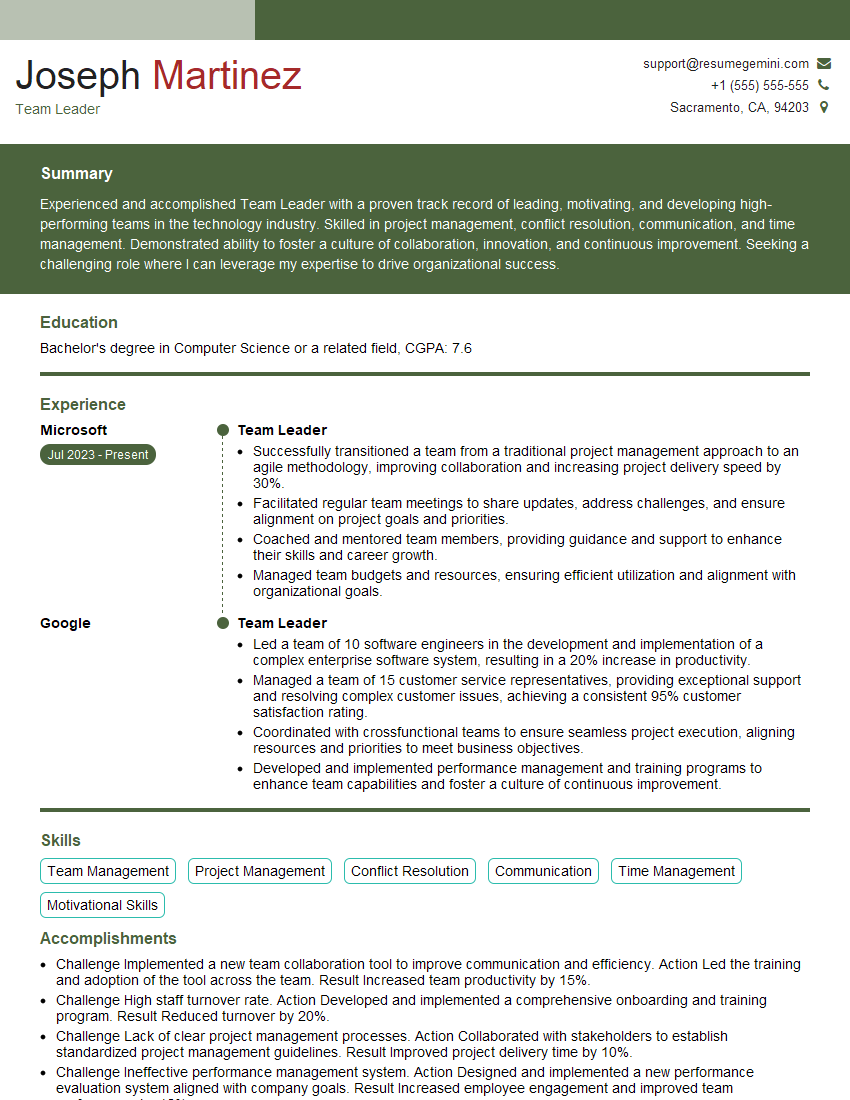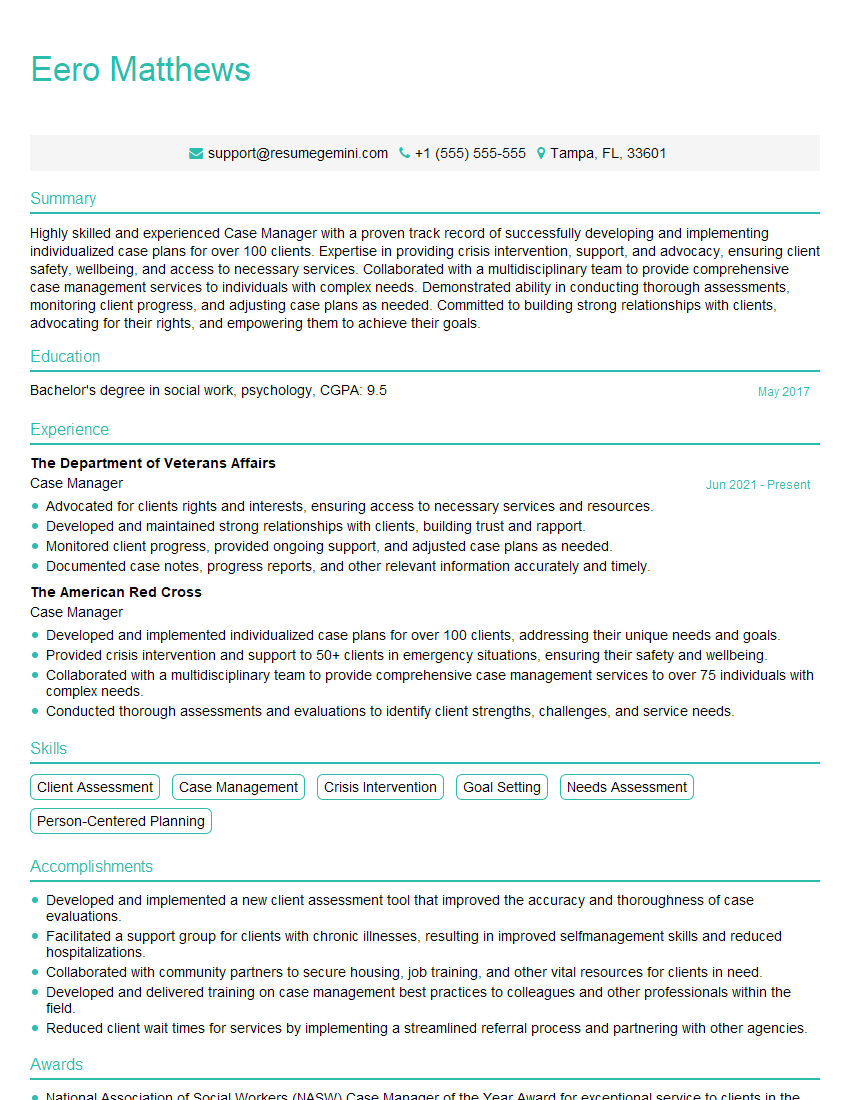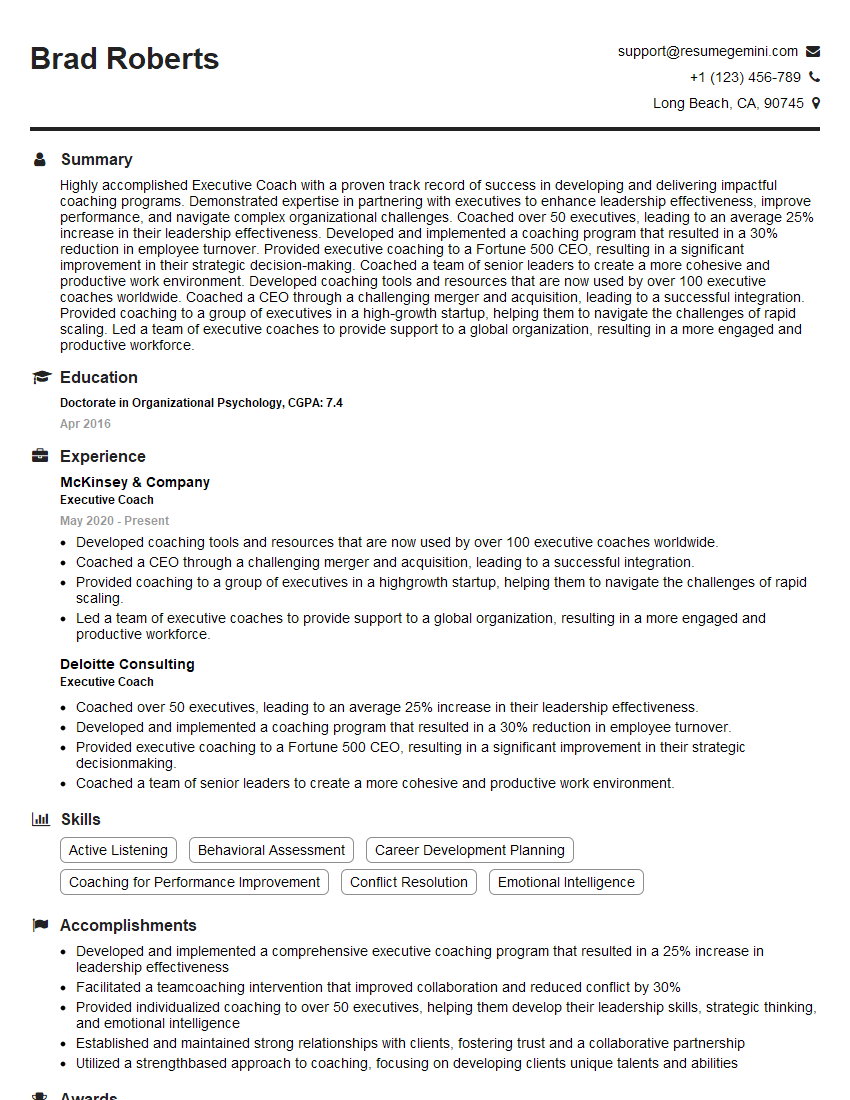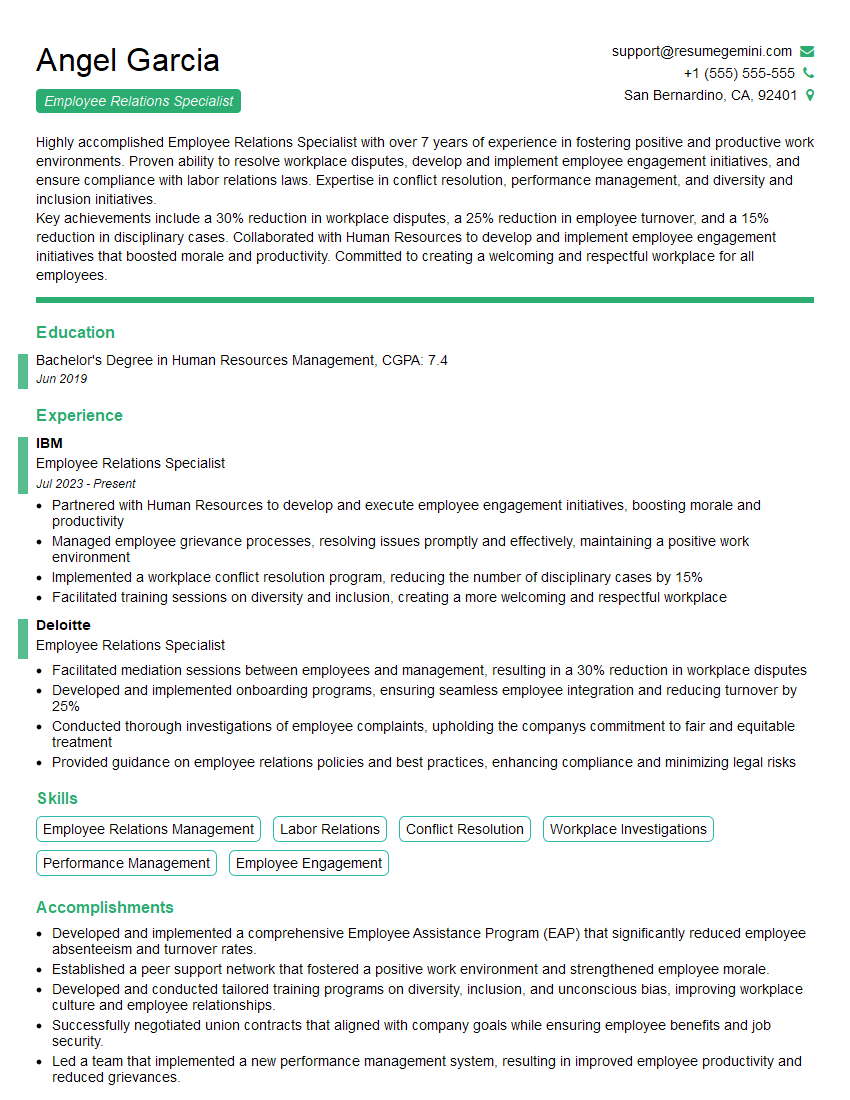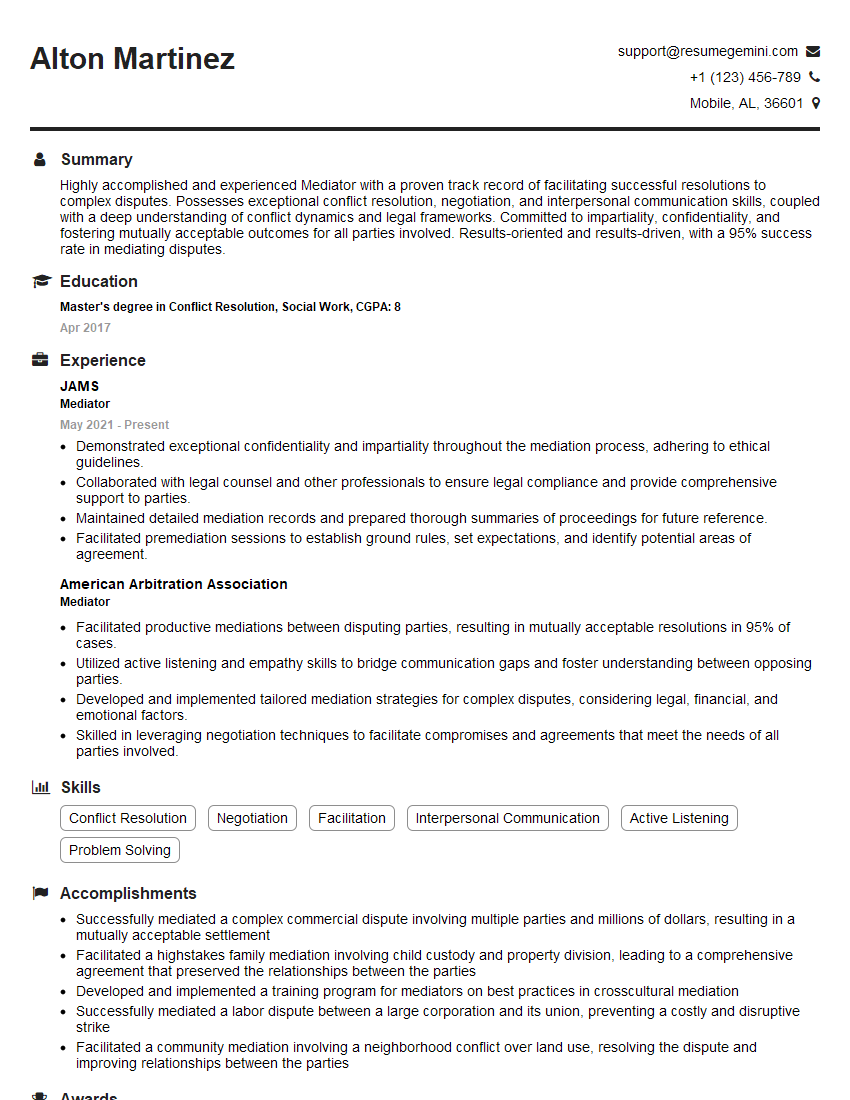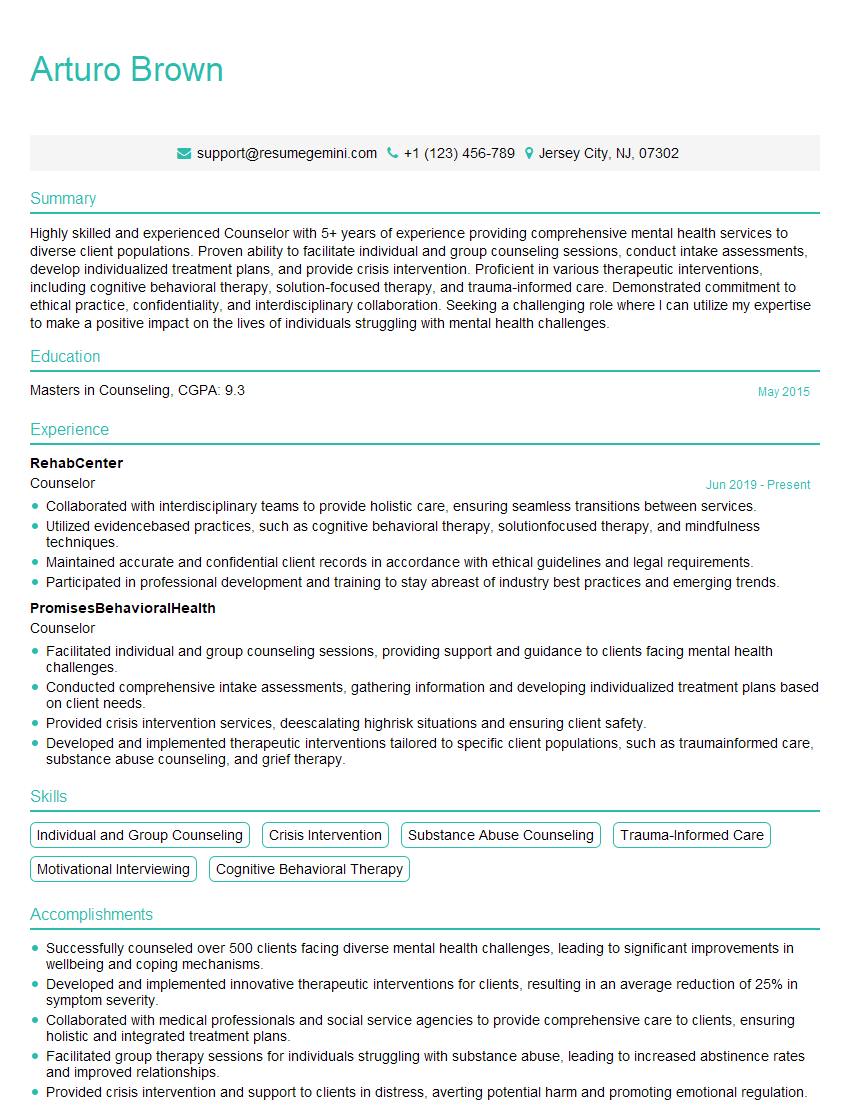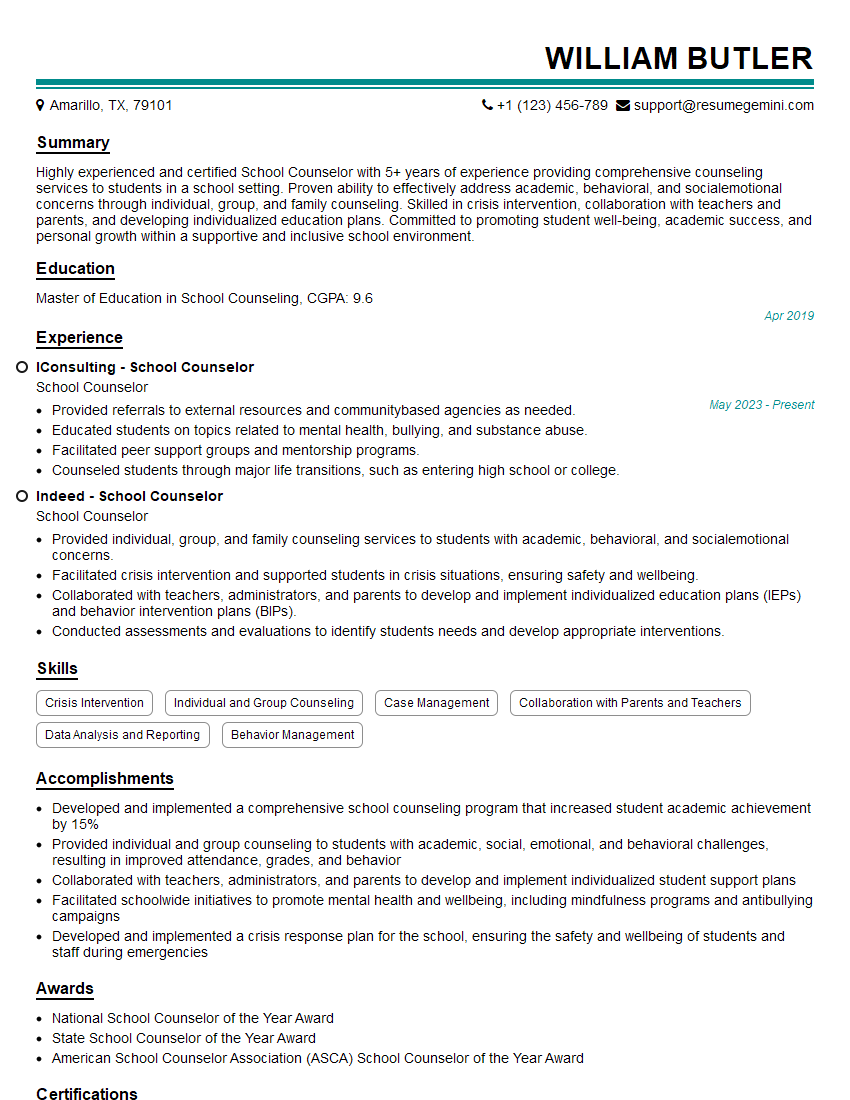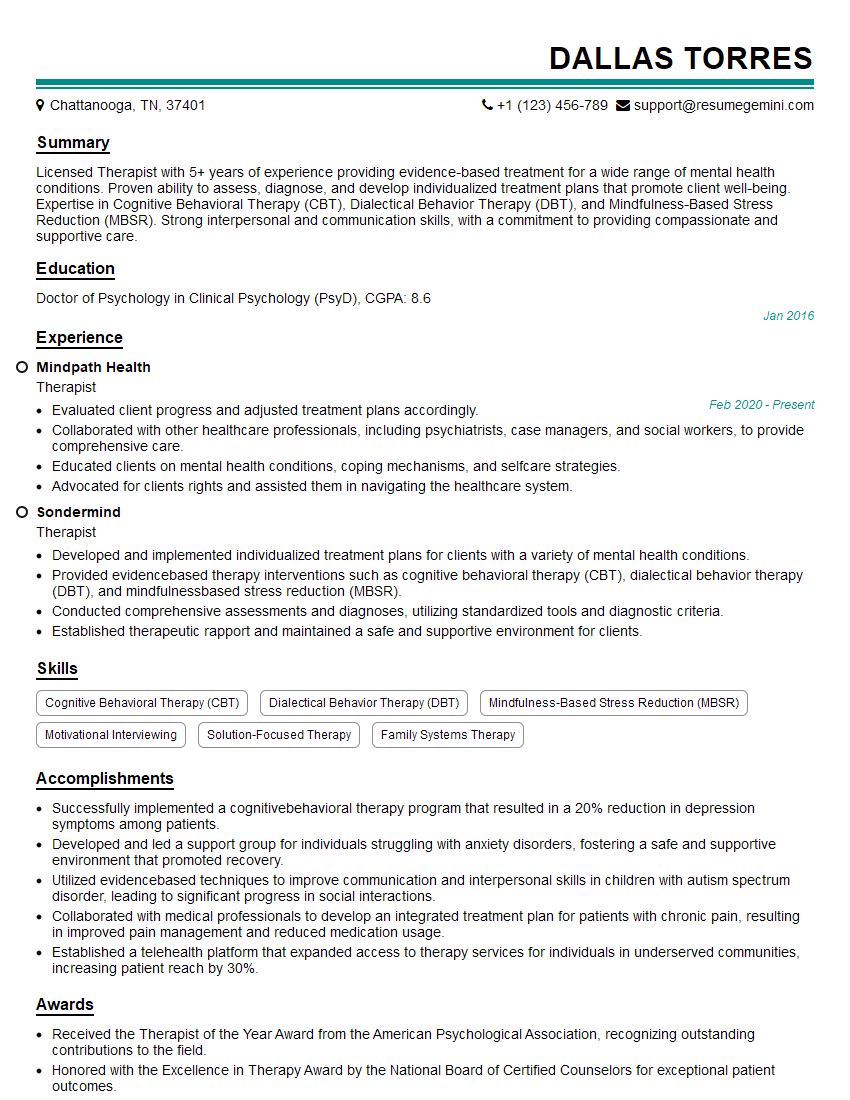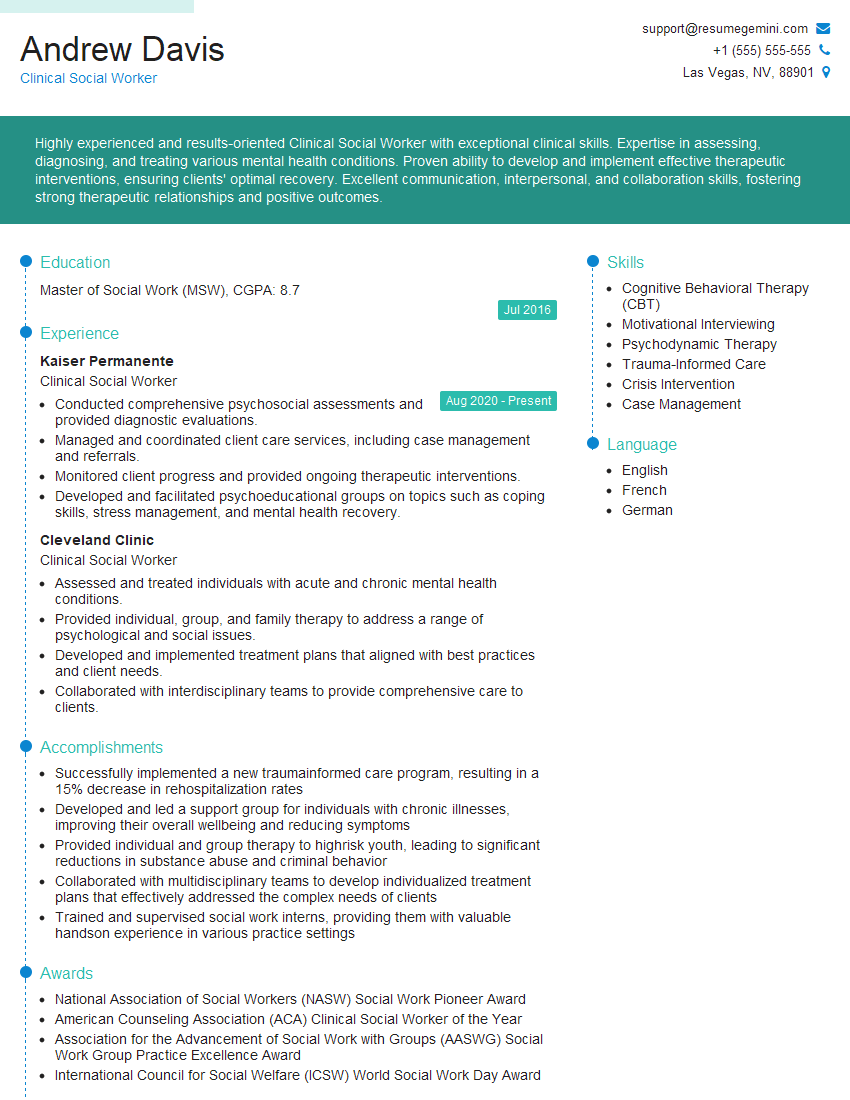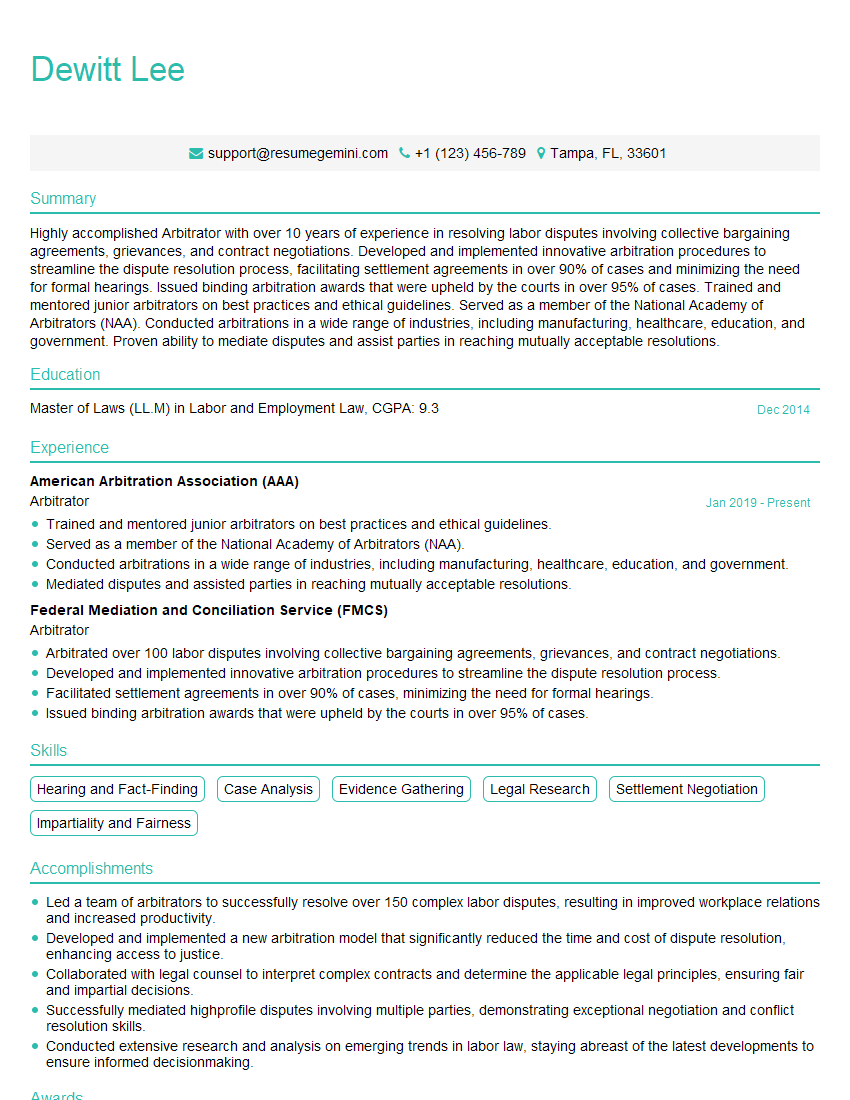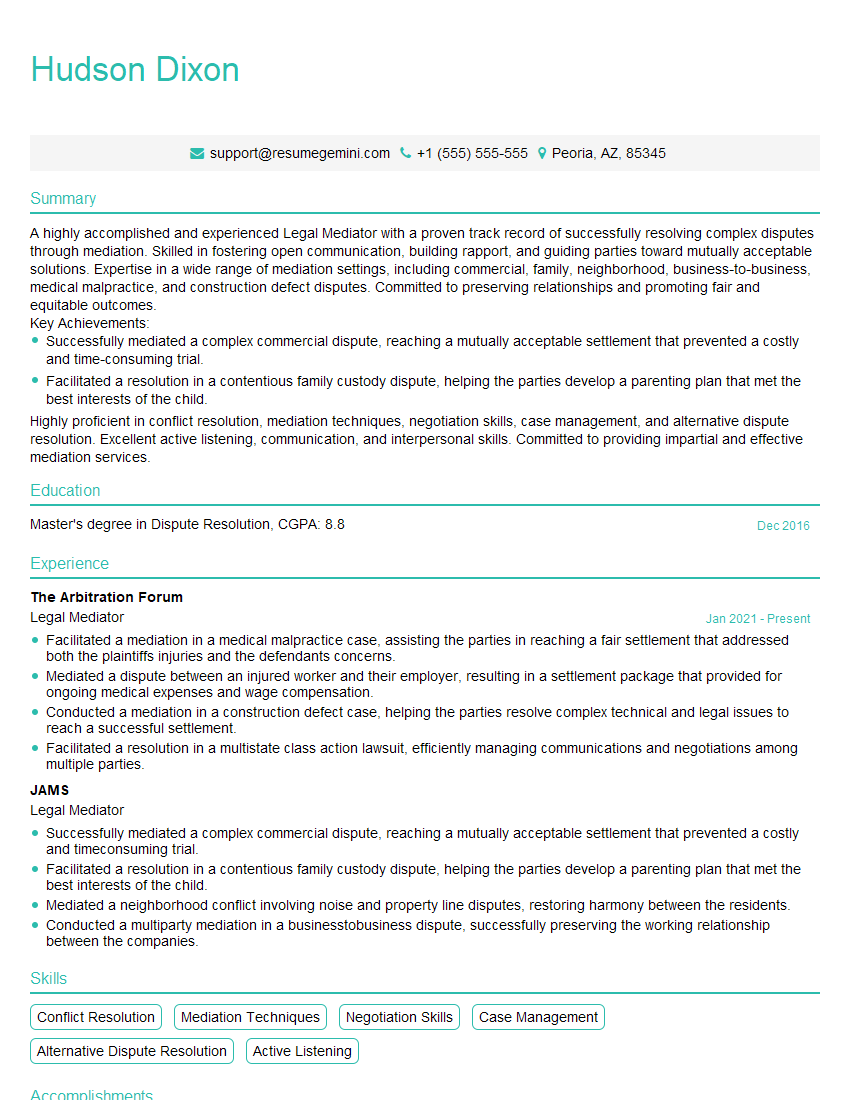Are you ready to stand out in your next interview? Understanding and preparing for Interpersonal and Conflict Resolution Skills interview questions is a game-changer. In this blog, we’ve compiled key questions and expert advice to help you showcase your skills with confidence and precision. Let’s get started on your journey to acing the interview.
Questions Asked in Interpersonal and Conflict Resolution Skills Interview
Q 1. Describe your approach to resolving a conflict between two team members with differing opinions.
My approach to resolving conflicts between team members starts with understanding the situation from each individual’s perspective. I don’t jump to conclusions or take sides. Instead, I facilitate a structured conversation using a collaborative problem-solving approach. This involves:
- Active Listening: I ensure each person feels heard and understood by paraphrasing their points and asking clarifying questions. This creates a safe space for open communication.
- Identifying Shared Goals: I help them identify common ground and the shared objective they both want to achieve. This shifts the focus from blame to collaboration.
- Brainstorming Solutions: Together, we brainstorm multiple potential solutions, focusing on practicality and feasibility. This empowers them to participate in the solution-finding process.
- Agreement & Action Plan: Once a solution is agreed upon, we collaboratively create an action plan with clear steps, responsibilities, and timelines. This ensures accountability and prevents future misunderstandings.
- Follow-up: I follow up to check on progress and address any new issues that may arise. This reinforces commitment and shows continued support.
For example, if two designers disagree on the color palette for a new website, I would facilitate a discussion where they each explain their rationale. We’d then explore how to incorporate elements from both palettes to create a visually appealing and effective design that satisfies both parties’ concerns.
Q 2. How do you handle a situation where a colleague is consistently undermining your work?
When faced with a colleague consistently undermining my work, I prioritize a professional and direct approach, focused on addressing the behavior, not making it personal. My strategy involves:
- Documenting Instances: I keep a detailed record of specific instances of undermining, including dates, times, and the nature of the actions. This provides concrete evidence if further action is needed.
- Private Conversation: I schedule a private meeting with the colleague to discuss my concerns. I use ‘I’ statements to express how their actions affect my work, without accusing or blaming. For example, ‘I feel frustrated when my proposals are changed without discussion.’
- Seeking Clarification: I try to understand the root cause of their behavior. Are they feeling insecure, overlooked, or do they have a different understanding of the project’s goals?
- Collaborative Problem-Solving: Together, we brainstorm ways to improve our working relationship and ensure smoother collaboration. This might involve clarifying roles, improving communication channels, or finding ways to utilize each other’s strengths more effectively.
- Escalation if Necessary: If the behavior continues despite these steps, I escalate the issue to my manager to seek guidance and support. Documentation from the previous steps is crucial in this process.
Remember, maintaining a professional tone is key, even when frustrated. The goal is to resolve the issue, not to engage in conflict.
Q 3. Explain a time you had to negotiate a compromise to achieve a shared goal.
During the launch of a new product, our marketing and sales teams had differing strategies. Marketing favored a high-profile, expensive campaign focusing on brand awareness, while sales prioritized a more targeted approach with a smaller budget, focusing on immediate sales conversions. The shared goal was a successful product launch.
To negotiate a compromise, I facilitated a meeting where each team presented their rationale. We identified the strengths and weaknesses of each approach and then collaboratively brainstormed a blended strategy. This involved a phased approach: an initial targeted campaign to generate early sales followed by a broader brand-awareness campaign once we had initial market data. This compromise allowed both teams to feel heard and contributed to a successful product launch that exceeded initial sales projections. It demonstrated that successful negotiation relies on mutual understanding and willingness to adapt.
Q 4. What strategies do you employ to de-escalate a tense situation?
De-escalating tense situations requires a calm and controlled approach. My strategies include:
- Active Listening and Empathy: I listen attentively without interrupting, attempting to understand the emotional state of each individual involved. I use empathetic statements like, ‘I understand this must be frustrating for you.’
- Creating a Safe Space: I create a calm and neutral environment where people feel comfortable expressing their feelings without fear of judgment or criticism.
- Using Calming Language: I avoid accusatory or confrontational language. Instead, I use calm, neutral tones and open-ended questions to encourage dialogue.
- Reframing the Situation: I help individuals reframe the situation by focusing on shared goals and common interests. This helps to shift the focus from negativity to finding solutions.
- Taking a Break if Needed: If the tension becomes too high, I suggest taking a break to allow individuals to cool down before resuming the conversation.
Think of it like defusing a bomb – you need a slow, careful approach. Rushing or escalating the situation will only make things worse.
Q 5. How do you identify the root cause of a conflict?
Identifying the root cause of a conflict requires careful investigation and a willingness to look beyond surface-level issues. My approach involves:
- Gathering Information: I gather information from all involved parties, including any relevant documentation or witnesses. It’s important to collect information from diverse perspectives to create a comprehensive understanding.
- Analyzing Communication Patterns: I analyze communication patterns to identify any miscommunications, misunderstandings, or lack of clarity. This often reveals underlying issues not explicitly stated.
- Exploring Underlying Needs: I dig deeper to understand the underlying needs and motivations of each person involved. Often, conflicts arise not from the issue itself, but from unmet needs or feelings of being unheard.
- Identifying Systemic Issues: I consider whether there are any systemic issues contributing to the conflict, such as unclear roles, inadequate resources, or organizational policies.
It’s like investigating a crime scene – you need to gather all the evidence before drawing conclusions. Jumping to conclusions without a thorough investigation can hinder the resolution process.
Q 6. Describe your experience mediating a dispute.
In a previous role, I mediated a dispute between two departments over resource allocation. Both departments felt they were under-resourced, leading to strained relationships and delays in project completion. My role as mediator was to facilitate a neutral and structured discussion. I employed several strategies:
- Establishing Ground Rules: I started by establishing ground rules for respectful communication, ensuring all parties felt safe to express their perspectives.
- Active Listening and Clarification: I ensured each department thoroughly explained their needs and concerns. I paraphrased their statements to ensure understanding and asked clarifying questions to address any ambiguities.
- Identifying Common Ground: I helped them identify shared goals, such as completing projects on time and maintaining a positive working relationship. This helped shift the focus from conflict to collaboration.
- Exploring Options: I guided them through brainstorming alternative resource allocation strategies, considering the needs of both departments. This involved considering the long-term implications of each option.
- Reaching a Mutually Acceptable Agreement: We collaboratively developed a solution that involved a temporary reallocation of resources, coupled with a commitment to improved inter-departmental communication and planning for future resource allocation.
Successfully mediating this dispute improved inter-departmental relations, increased productivity, and set a positive precedent for future resource allocation decisions.
Q 7. How do you build rapport with individuals from diverse backgrounds?
Building rapport with individuals from diverse backgrounds requires cultural sensitivity, empathy, and a genuine interest in understanding others. My approach involves:
- Active Listening and Observation: I pay close attention to both verbal and nonverbal cues, demonstrating respect for cultural differences in communication styles.
- Showing Genuine Interest: I actively engage in conversation, asking questions about their backgrounds, experiences, and perspectives. This demonstrates genuine curiosity and a desire to connect.
- Cultural Sensitivity: I am mindful of potential cultural differences in communication styles, body language, and personal space. I am careful to avoid generalizations and stereotypes.
- Adapting Communication Style: I adjust my communication style to suit the individual’s communication preferences. This might involve being more direct or indirect, depending on the cultural context.
- Seeking Feedback: I proactively seek feedback to ensure my communication is well-received and to identify areas for improvement. This demonstrates a commitment to understanding and building strong relationships.
Building rapport is like building any other relationship – it takes time, effort, and a genuine desire to connect with others on a personal level.
Q 8. What techniques do you use to actively listen and understand different perspectives?
Active listening isn’t just hearing; it’s truly understanding the other person’s perspective. I employ several techniques to achieve this. Firstly, I focus entirely on the speaker, minimizing distractions and offering my full attention. This includes maintaining eye contact (while being mindful of cultural norms), using open and inviting body language, and nodding to show I’m engaged. Secondly, I use paraphrasing and reflective listening to confirm my understanding. For example, I might say, ‘So, if I understand correctly, you’re feeling frustrated because…’ This ensures I’m accurately interpreting their message. Thirdly, I ask clarifying questions to delve deeper into their viewpoint. These questions should be open-ended, encouraging elaboration rather than simply yes/no answers. Finally, I summarize key points at the end to demonstrate I’ve grasped the core issues and ensure we’re on the same page.
For instance, in a recent team meeting, a colleague expressed concern about a project deadline. Instead of immediately jumping to solutions, I actively listened, paraphrasing their concerns and asking questions about the specific challenges they faced. This allowed me to understand the root cause of their anxiety and find a collaborative solution.
Q 9. How do you manage your emotions during a conflict?
Managing emotions during conflict is crucial for effective resolution. My approach is multifaceted. First, I recognize and acknowledge my own emotions. This self-awareness helps me understand the source of my reactions and prevents impulsive responses. Techniques like deep breathing and mindfulness help regulate my physiological response to stress. Secondly, I actively strive to remain calm and objective, focusing on the issue at hand rather than getting caught up in emotional exchanges. Thirdly, I utilize empathy to understand the other party’s emotional state. Recognizing their feelings, even if I don’t agree with their perspective, helps de-escalate tension. Finally, if necessary, I take a brief break to compose myself before resuming the conversation. This ensures I approach the situation with a clear head and prevent escalating the conflict further. Think of it like pressing pause on a heated argument to allow emotions to cool down.
Q 10. Explain a time you had to deliver difficult feedback.
I once had to deliver difficult feedback to a team member whose work quality had consistently fallen below expectations. I approached the situation with care, scheduling a private meeting to ensure a safe and confidential space. I started by acknowledging their past contributions and highlighting their strengths before addressing the performance issues. I used the ‘Situation-Behavior-Impact’ (SBI) model, specifically describing observable behaviors and their impact on the team and project timelines. For example, instead of saying ‘You’re lazy,’ I said, ‘In the past few weeks, deadlines for your tasks haven’t been met (Situation), which resulted in delays for the entire team (Impact), specifically impacting the integration phase (Behavior).’ I then collaboratively discussed potential solutions and offered support and resources, fostering a sense of partnership rather than blame. This approach resulted in improved performance and strengthened our working relationship.
Q 11. Describe your experience using different conflict resolution styles (e.g., competing, collaborating, compromising).
My experience with different conflict resolution styles is varied and depends heavily on the context. I frequently utilize collaborating, seeking a win-win solution where both parties’ needs are met. This style is effective when there is time and trust between involved parties. For instance, resolving a disagreement between team members about project allocation through open communication and brainstorming yielded a more equitable distribution, satisfying everyone involved. However, sometimes time constraints or power dynamics necessitate a more pragmatic approach. In such cases, compromising might be the better option—finding a middle ground that addresses the key concerns of all parties. For example, compromising on deadlines during a tight project schedule allowed for progress without sacrificing quality. I rarely use competing, which focuses solely on one party’s needs, as it is often counterproductive in building long-term relationships. I only resort to it in situations involving safety or ethical violations. Avoiding or accommodating are also strategies I use selectively, choosing avoidance only when the conflict is trivial or when cooling-off periods are needed.
Q 12. How do you ensure fair and equitable outcomes in conflict resolution?
Ensuring fair and equitable outcomes requires impartiality, objectivity, and a thorough understanding of all perspectives. I achieve this by actively listening to all parties involved, gathering information impartially, and avoiding preconceived judgments. I also strive to create a safe space for open dialogue, where everyone feels comfortable expressing their concerns without fear of retribution. Moreover, I focus on the issue at hand, not on personalities or past grievances. When appropriate, I use objective criteria (e.g., company policies, legal precedents) to guide decisions. Transparency in my decision-making process is key, explaining the rationale behind the chosen solution and ensuring all parties understand the reasoning. If needed, I involve neutral third parties or mediation processes to facilitate objective resolution.
Q 13. What are the key elements of effective communication in conflict resolution?
Effective communication in conflict resolution hinges on several key elements. Clarity is paramount—expressing thoughts and feelings clearly and concisely, avoiding ambiguity or jargon. Empathy is equally important—understanding and acknowledging the other party’s perspective, even if you disagree. Respectful language is essential—avoiding accusatory or demeaning tones, maintaining a professional and courteous demeanor. Active listening, as mentioned earlier, is crucial to truly understand concerns. Finally, Non-violent communication, which focuses on expressing needs and feelings without blame, helps build trust and facilitates collaborative resolution. This framework allows for constructive dialogue and leads to more positive outcomes.
Q 14. How do you assess the level of conflict and choose an appropriate strategy?
Assessing conflict level is crucial for choosing the right strategy. I consider several factors. The intensity of emotions involved (high or low), the complexity of the issue (simple or multifaceted), the relationship between involved parties (formal or informal), and the time constraints (urgent or less urgent) all influence my approach. Low-intensity conflicts with simple issues often require minimal intervention; perhaps a brief discussion or a simple clarification. High-intensity or complex conflicts involving formal relationships might necessitate more structured approaches like mediation or negotiation. Urgent conflicts might require immediate intervention, possibly using more assertive techniques initially to de-escalate the situation. I use a combination of observation, active listening, and questioning to assess these factors before determining the most appropriate and effective resolution strategy.
Q 15. Describe a situation where you had to manage a difficult personality.
Managing difficult personalities requires a nuanced approach that prioritizes understanding, empathy, and clear communication. It’s not about changing the person, but about managing the interaction effectively.
In a previous role, I worked with a team member who was extremely critical and often disruptive during meetings. Instead of confronting them directly, which might have escalated the situation, I opted for a more indirect approach. First, I privately acknowledged their expertise and contributions to the team, recognizing their value despite their challenging communication style. This helped foster a sense of collaboration. Then, during meetings, I made sure to actively include them early, giving them opportunities to express their opinions before their criticisms became disruptive. Finally, I implemented a structured meeting agenda that kept discussions focused and on track, minimizing opportunities for unnecessary interruptions. This approach gradually reduced the negative impact of their personality on team dynamics, improving overall productivity and morale.
Career Expert Tips:
- Ace those interviews! Prepare effectively by reviewing the Top 50 Most Common Interview Questions on ResumeGemini.
- Navigate your job search with confidence! Explore a wide range of Career Tips on ResumeGemini. Learn about common challenges and recommendations to overcome them.
- Craft the perfect resume! Master the Art of Resume Writing with ResumeGemini’s guide. Showcase your unique qualifications and achievements effectively.
- Don’t miss out on holiday savings! Build your dream resume with ResumeGemini’s ATS optimized templates.
Q 16. How do you foster a positive and collaborative work environment?
Fostering a positive and collaborative work environment involves creating a culture of respect, open communication, and shared goals. It’s about building trust and ensuring everyone feels valued and heard.
- Open Communication Channels: Implementing regular team meetings, informal check-ins, and accessible communication tools ensures information flows freely and reduces misunderstandings.
- Clear Expectations and Roles: Establishing clear goals, responsibilities, and performance expectations minimizes conflict arising from ambiguity.
- Recognition and Appreciation: Regularly acknowledging and appreciating team members’ contributions fosters a sense of belonging and encourages collaboration. This can be as simple as a verbal ‘thank you’ or a more formal team recognition program.
- Conflict Resolution Training: Providing team members with conflict resolution skills empowers them to manage disagreements constructively.
- Team-Building Activities: Engaging in activities outside of work that promote camaraderie and trust can strengthen team bonds.
For example, in my previous team, we implemented a ‘Kudos’ system where team members could publicly acknowledge each other’s achievements. This simple initiative significantly boosted team morale and fostered a more positive and appreciative atmosphere.
Q 17. How do you handle disagreements with your superiors?
Disagreements with superiors require a respectful and professional approach. The key is to focus on solutions and maintain a collaborative tone.
- Prepare your argument: Gather data and evidence to support your perspective before approaching your superior.
- Choose the right time and place: Schedule a private meeting to discuss the issue calmly and professionally.
- Focus on the problem, not the person: Frame the disagreement as a problem to be solved together, rather than a personal attack.
- Listen actively and respectfully: Understand your superior’s perspective and be open to their feedback.
- Seek common ground: Aim to find a mutually agreeable solution that addresses both your concerns and your superior’s objectives.
- Document the discussion: Maintain records of the discussion and any agreed-upon actions.
For instance, if I disagreed with a superior’s decision on a project deadline, I would present data on the workload and potential risks of missing the deadline, proposing alternative solutions to meet the objectives without compromising quality.
Q 18. What are your strengths and weaknesses in conflict resolution?
My strengths in conflict resolution lie in my ability to remain calm and empathetic under pressure, my active listening skills, and my capacity to find creative solutions. I’m skilled at facilitating open communication and guiding individuals towards mutually beneficial outcomes.
A weakness I’m actively working on is managing conflicts involving strong emotions. While I can usually navigate disagreements objectively, I sometimes find it challenging to de-escalate highly emotional situations quickly. I’m addressing this by investing in further training in emotional intelligence and conflict de-escalation techniques.
Q 19. How do you prioritize competing demands during a conflict situation?
Prioritizing competing demands during a conflict requires a structured approach. It’s about identifying the most critical issues and focusing on those first, while acknowledging the others.
- Assess the urgency and importance: Use a prioritization matrix (such as Eisenhower’s Urgent/Important matrix) to categorize each demand based on urgency and importance.
- Identify stakeholders: Determine who is impacted by each demand and prioritize based on the level of impact.
- Consider potential consequences: Evaluate the potential positive and negative consequences of addressing each demand.
- Negotiate and compromise: Explore options for compromise or collaboration to address multiple demands effectively.
- Communicate transparently: Keep all stakeholders informed of the prioritization process and rationale behind the decisions.
For example, if during a project conflict, there were competing demands for resources and timeline adjustments, I would analyze the impact of each, using the prioritization matrix to guide my decisions and ensure that critical aspects of the project are not compromised.
Q 20. How do you adapt your conflict resolution approach based on the situation and individuals involved?
Adapting my approach to conflict resolution depends on understanding the context and the individuals involved. There is no one-size-fits-all solution.
- Individual Styles: Some individuals prefer direct confrontation, others prefer mediation. I adapt my communication style accordingly, understanding each person’s preferred method for conflict resolution.
- Relationship Dynamics: The existing relationship between the conflicting parties significantly influences the approach. A collaborative approach might be suitable for colleagues with a positive working relationship, whereas a more structured mediation process may be necessary for individuals with a strained relationship.
- Conflict Type: Different conflict types require different interventions. For example, a simple misunderstanding may only need clarification, whereas a complex conflict with multiple underlying issues may require a more comprehensive approach involving negotiation, mediation, or even arbitration.
- Organizational Culture: The organization’s culture can influence the appropriate approach to conflict. Some organizations foster a culture of open communication and direct confrontation, while others emphasize a more collaborative and indirect approach.
This adaptability ensures that my interventions are effective and appropriate, leading to positive and sustainable outcomes.
Q 21. Describe a time you failed to resolve a conflict successfully and what you learned from it.
In a previous team project, I attempted to resolve a conflict between two team members using a direct confrontation approach, which unfortunately backfired. The conflict involved differing opinions about the project’s direction, and my attempt to mediate directly led to heightened emotions and further escalation.
What I learned from this experience is the importance of choosing the right approach based on the specific context and personalities involved. Direct confrontation, while sometimes effective, can be counterproductive in highly emotional situations. In hindsight, a more collaborative approach, possibly involving a neutral third party, would have been more successful. Since then, I’ve improved my ability to assess situations more accurately and choose the most appropriate conflict resolution strategy.
Q 22. How do you maintain impartiality during a conflict?
Maintaining impartiality in conflict resolution is crucial for building trust and ensuring a fair outcome. It means avoiding taking sides, showing equal respect to all parties involved, and focusing on the objective facts rather than personal biases or opinions. Think of it like being a referee in a game – you need to apply the rules fairly to both teams, regardless of your personal preferences.
To achieve impartiality, I actively listen to all perspectives without interrupting, ask clarifying questions to understand each party’s viewpoint completely, and avoid making judgments or expressing personal opinions. I focus on the common ground and shared goals to find solutions that satisfy everyone’s interests as much as possible. I also use structured conflict resolution techniques like mediation or facilitation, which provide a framework for neutral and objective conflict management.
Q 23. How do you ensure confidentiality in conflict resolution processes?
Confidentiality is paramount in conflict resolution. Sharing sensitive information without consent can damage trust, hinder the process, and even have legal repercussions. It’s vital to create a safe space where individuals feel comfortable sharing their experiences without fear of their disclosures being publicized.
I ensure confidentiality by explicitly stating at the outset of any conflict resolution process that all information shared will be kept strictly confidential. I avoid mentioning specific details in casual conversations or written records, referring to parties only by code names or initials when necessary. I also adhere to any relevant data protection laws and company policies regarding the handling of sensitive information. For example, I would never discuss a specific case with colleagues or friends unless absolutely necessary and with the expressed consent of all involved parties. And, I always use secure platforms for communication and storage of documents.
Q 24. How do you document and track the progress of a conflict resolution process?
Thorough documentation and progress tracking are essential for accountability, transparency, and effective conflict management. It helps monitor the progress, identify potential roadblocks, and ensure that the agreed-upon solutions are implemented. I typically use a combination of methods to achieve this.
This might include maintaining detailed meeting notes documenting key discussions, agreements, and action items. I often use a dedicated case management system or software to track communication, deadlines, and progress towards resolution. I also maintain a chronology of events, including dates, times, and participants. This structured approach ensures a clear record of the entire process for all stakeholders. Regular progress updates shared with the participants keep everyone informed and engaged in the process.
Q 25. Describe a time you had to use empathy and emotional intelligence in conflict resolution.
In a previous role, I mediated a conflict between two team members who had a significant personality clash, affecting team productivity. One member was highly assertive and direct, while the other was more introverted and sensitive. Their communication styles clashed, leading to misunderstandings and resentment.
To resolve this, I employed empathy and emotional intelligence. I actively listened to each individual’s perspective, validating their feelings without condoning their behavior. I recognized the assertive team member’s need for efficiency and the introverted member’s need for careful consideration. By understanding their underlying emotional needs, I facilitated a conversation where they could articulate their concerns without interruption. I helped them reframe their communication, suggesting alternative approaches that respected each other’s styles. The outcome was a mutual understanding, improved communication, and a much more harmonious working relationship.
Q 26. How do you define success in conflict resolution?
Success in conflict resolution isn’t always about finding a ‘winner’ but about achieving a mutually acceptable outcome that addresses the core issues and fosters a better relationship between the parties involved. It’s about building bridges and restoring harmony, even if it means compromise from everyone. A successful resolution leaves all parties feeling heard, understood, and respected.
I define success through several key indicators: a clear and mutually agreed-upon resolution to the conflict; improved communication and relationships between the involved parties; the implementation of agreed-upon actions; and a reduction in negative emotions and behaviors. Long-term success is also measured by the sustained positive relationships and the prevention of future conflicts between the same parties.
Q 27. How do you prevent conflicts from escalating?
Preventing conflict escalation requires proactive strategies focused on early intervention and de-escalation techniques. Addressing issues promptly before they become entrenched is crucial. Think of it like tending to a small fire before it becomes a raging inferno.
My approach includes establishing clear communication channels and expectations from the outset. I encourage open dialogue, active listening, and empathy to address concerns early on. When conflict arises, I focus on managing emotions by remaining calm and professional, actively listening, validating concerns, and reframing negative statements into more constructive language. Techniques like creating a safe space for communication, helping parties identify common goals, and finding areas of agreement can help de-escalate tensions and facilitate positive outcomes.
Q 28. What are your thoughts on restorative justice and its role in conflict resolution?
Restorative justice is a powerful approach to conflict resolution that focuses on repairing harm and restoring relationships rather than simply punishing wrongdoers. It emphasizes dialogue, accountability, and collaboration among all involved parties. Instead of focusing solely on punishment, it aims to address the underlying causes of the conflict and facilitate healing and reconciliation.
I believe restorative justice has a valuable role in various conflict resolution settings. It’s particularly effective in community-based conflicts or situations where the harm is relational. By bringing together those affected by the conflict, restorative justice practices help create opportunities for dialogue, empathy, and shared problem-solving. It promotes accountability, allowing offenders to take responsibility for their actions and make amends. Ultimately, it contributes to stronger community bonds and a more peaceful environment.
Key Topics to Learn for Interpersonal and Conflict Resolution Skills Interview
- Active Listening & Empathetic Communication: Understanding nonverbal cues, paraphrasing to confirm understanding, and responding with empathy to build rapport and de-escalate conflict.
- Conflict Styles & Management: Identifying your own conflict style and learning to adapt your approach based on the situation and the individuals involved. This includes understanding accommodating, collaborating, competing, avoiding, and compromising styles.
- Negotiation & Mediation Techniques: Practicing effective negotiation strategies, including identifying interests, finding common ground, and reaching mutually acceptable solutions. Understanding the principles of mediation and how to facilitate constructive dialogue.
- Assertiveness & Boundary Setting: Expressing your needs and opinions clearly and respectfully while respecting the needs and opinions of others. Learning to set and maintain healthy boundaries.
- Emotional Intelligence (EQ): Recognizing and understanding your own emotions and the emotions of others, and using this awareness to guide your interactions and responses during conflict.
- Problem-Solving & Decision-Making in Conflict Situations: Applying structured problem-solving frameworks to identify the root causes of conflict and collaboratively develop effective solutions.
- Teamwork & Collaboration: Understanding the dynamics of teamwork and how to contribute effectively to a collaborative environment, resolving disagreements constructively.
- Cultural Sensitivity & Awareness: Recognizing how cultural differences can influence communication styles and conflict resolution approaches. Adapting your communication to foster understanding and respect across different cultures.
Next Steps
Mastering interpersonal and conflict resolution skills is crucial for career advancement. These skills are highly valued across all industries, demonstrating your ability to work effectively in teams, navigate challenging situations, and build strong relationships. To significantly boost your job prospects, creating a well-structured, ATS-friendly resume is essential. ResumeGemini is a trusted resource to help you build a professional resume that highlights your accomplishments and skills effectively. We provide examples of resumes tailored to emphasize interpersonal and conflict resolution skills to help you get started. Invest in your future – craft a resume that showcases your strengths and helps you land your dream job.
Explore more articles
Users Rating of Our Blogs
Share Your Experience
We value your feedback! Please rate our content and share your thoughts (optional).
What Readers Say About Our Blog
Hi, I represent an SEO company that specialises in getting you AI citations and higher rankings on Google. I’d like to offer you a 100% free SEO audit for your website. Would you be interested?
good





